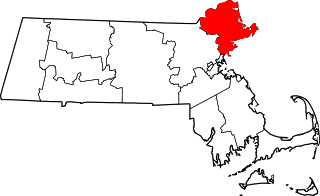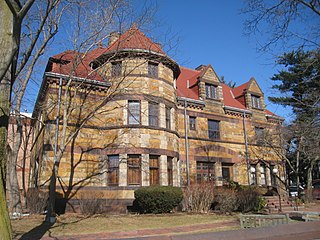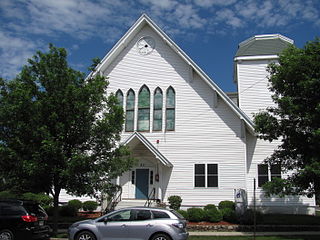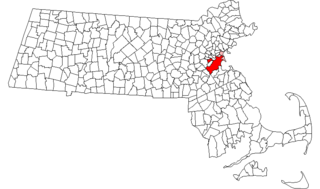
This list is of that portion of the National Register of Historic Places (NRHP) designated in Essex County, Massachusetts. The locations of these properties and districts for which the latitude and longitude coordinates are included below, may be seen in a map.
This is a list of properties and historic districts listed on the National Register of Historic Places in Norfolk County, Massachusetts, other than those within the city of Quincy and the towns of Brookline and Milton. Norfolk County contains more than 300 listings, of which the more than 100 not in the above three communities are listed below. Some listings extend across municipal boundaries, and appear on more than one list.

Follen Church is a historic Unitarian Universalist congregation located at 755 Massachusetts Avenue in Lexington, Massachusetts, United States.

This is a list of sites listed on the National Register of Historic Places in Cambridge, Massachusetts. This is intended to be a complete list of the properties and districts on the National Register of Historic Places in Cambridge, Massachusetts, United States. Latitude and longitude coordinates are provided for many National Register properties and districts; these locations may be seen together in an online map.

The Theodore W. Richards House is a National Historic Landmark at 15 Follen Street in Cambridge, Massachusetts. Built in 1900, it was the home until his death of Theodore William Richards (1868–1928), the first American to be awarded the Nobel Prize in Chemistry. Richards was a leading experimental chemist of his day, measuring the atomic weights of a large number of elements. He was also responsible for the growth of Harvard University's graduate chemistry program to one of the finest in the nation. The house was designated a National Historic Landmark in 1976.

The Edwin Abbot House, also known as the Zabriskie House, is an historic house at 27 Garden Street in Cambridge, Massachusetts. Built in 1889 to a design by Longfellow, Alden & Harlow, it is a prominent local example of residential Richardsonian Romanesque architecture. It has served as the principal building of the Longy School since 1937. It was listed on the National Register of Historic Places in 1979, and included in the Follen Street Historic District in 1986.

The Building at 10 Follen Street is a historic house at 10 Follen Street in Cambridge, Massachusetts. The three-story wood-frame house was designed by Peabody & Stearns and built in 1875. It is a rare well-preserved example of the transition between Second Empire and Stick styles, with a truncated hip roof, a highly decorated porch, and most of its original interior woodwork.

Cloverden is an historic house at 29 Follen Street in Cambridge, Massachusetts. It is a 2+1⁄2-story wood-frame structure, five bays wide, with a side-gable roof, two asymmetrically placed chimneys, and clapboard siding. A single-story porch extends across the front, supported by Doric columns. The Greek Revival house was built in 1837.

The Harvard Houses Historic District is a historic district encompassing seven of Harvard College's residential houses. The district is roughly bounded by Mt. Auburn, Grant, and Cowperwaite Streets, Banks Street and Putman Avenue, Memorial Drive, and JFK Street in Cambridge, Massachusetts. The contributing buildings to the district are predominantly residential dormitory buildings which were constructed between 1913 and 1930, and are Georgian Revival in style. There are three small residential buildings which were built in the 18th and 19th centuries, and a number of non-contributing later buildings, including among others the towers of Leverett House and the modern portion of Quincy House at 58 Plympton Street. The buildings are an imposing presence in the streetview of Memorial Drive between Western Avenue and the Anderson Memorial Bridge, but their massing is interrupted by mature tree plantings, and they are organized to provide courtyards and quadrangles in the interior of the district.

The Old Cambridge Historic District is a historic district encompassing a residential neighborhood of Cambridge, Massachusetts that dates to colonial times. It is located just west of Harvard Square, and includes all of the properties on Brattle Street west of Mason Street to Fresh Pond Parkway, all of the properties on Mason Street and Elmwood Avenue, and nearby properties on Craigie Street. The district includes five National Historic Landmarks: Elmwood, the Reginald A. Daly House, the Oliver Hastings House, the Mary Fiske Stoughton House, and the Longfellow House–Washington's Headquarters National Historic Site, as well as several other houses listed separately on the National Register. The district follows the general route of the Watertown Path, an early colonial road that supposedly followed a Native American trail. This portion of the way became known as Tory Row during the American Revolution, because many of the fine mansions lining it were owned by Loyalists. In the 19th and early 20th centuries it continued by a fashionable location, and now features a number of architecturally significant buildings. It includes 215 contributing buildings and one other contributing sites over an area of 52 acres (21 ha). One included building is the Cambridge Historical Society's offices, which are in the NRHP-listed Hooper-Lee Nichols House, located at 159 Brattle Street.

The Second Waterhouse House is an historic house at 9 Follen Street in Cambridge, Massachusetts. The 2+1⁄2-story wood-frame house was built on 1844, and is the most quintessentially Greek Revival house in the Follen Street Historic District. It was built by Benjamin Waterhouse, and is one of the earliest houses built on the street. Of particular historical interest is the assortment of heating systems that have been installed in the house since 1853, remnants of some of which are still found in the house's basement.

The Chestnut Street District is a historic district bounded roughly by Bridge, Lynn, Beckford, and River Streets in Salem, Massachusetts. It was added to the National Register of Historic Places in 1973 and enlarged slightly in 1978. The district contains a number of architecturally significant works of Samuel McIntire, a builder and woodworker who had a house and workshop at 31 Summer Street, and who designed and built a number of these houses, and others that display the profits made in the Old China Trade by Salem's merchants. The district is a subset of a larger locally designated McIntire Historic District.

The Lynn Common Historic District encompasses the town common of Lynn, Massachusetts and the surrounding buildings which face it. Although its establishment dates to the late 17th century, the area's time of development is predominantly in the 19th century, when the common was transformed into a park. The common is an elongated grassy area, flanked by North and South Common Streets, with a number of small cross streets breaking it into several pieces. City Hall Square marks its eastern boundary, and Market Square its western.

The Common Historic District is a historic district encompassing the civic and institutional heart of Reading, Massachusetts. The district is centered on the town common, at the intersection of Main and Salem Streets. The common has been communally owned since at least 1737, with the original burying ground to the north. In 1769 the area's first meeting house was built, giving the area a sense of identity separate from portions of Reading that would later be set off as Wakefield and North Reading. Since then the area has become a focal point for religious and civic institutions in the town.

The First Unitarian Church is a historic former church building in Stoneham, Massachusetts. One of Stoneham's more stylish Gothic Revival buildings, the Stick style wood structure was built in 1869 for a Unitarian congregation that was organized in 1858. The building was listed on the National Register of Historic Places in 1984, and included in the Central Square Historic District in 1990. It presently houses the local Community Access Television organization.

Boston, Massachusetts is home to many listings on the National Register of Historic Places. This list encompasses those locations that are located north of the Massachusetts Turnpike. See National Register of Historic Places listings in southern Boston for listings south of the Turnpike. Properties and districts located elsewhere in Suffolk County's other three municipalities are also listed separately.
Maurice Bigelow Biscoe was an American architect. He worked in New York and then moved to Denver, Colorado. He returned to the east to work in Boston. His work was part of the architecture event in the art competition at the 1932 Summer Olympics. A number of his works are listed on the U.S. National Register of Historic Places.

The Head of the River Historic District is a historic district encompassing a village area at the head of navigation of the Acushnet River, which separates Acushnet and New Bedford, Massachusetts. The village is centered at the junction of Tarkin Hill Road, River Road, and Mill Road in New Bedford, and Main Street in Acushnet. The area went through two significant periods of development: the first was in the late 18th and early 19th century, and the second was in the early 20th century. The district was listed on the National Register of Historic Places in 2009.

The Charlestown Main Street Historic District encompasses the historic heart of Charlestown, New Hampshire. It is located along Main Street, roughly between Lower Landing Road and Bridge Street, and encapsulates more than two hundred years of the town's history. The district was listed on the National Register of Historic Places in 1987.
Follen is a surname. Notable people with the surname include:




















